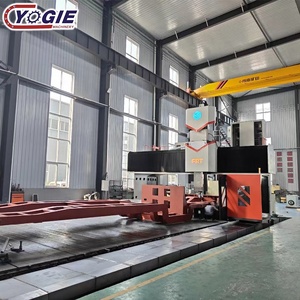(1045 products available)















































































































































































































The CNC milling machine works in a way that cuts materials with the use of a controller that is computer-based. It is a process commonly used to create and shape parts from materials like aluminum, metal, plastic, wood, etc. This technique is usually used to lay out and/or make pieces for complex builds and projects.
CNC milling machines have different types that can be used for any project with ease. Here are some common types:
CNC moving column milling machine's specifications vary depending on the model. Key specifications include the machine's size, axle's load capacity, work table's bearing capacity, maximum feed rate, and power.
Milling machines with a moving column design typically require less maintenance than other machines because the machine's part do not wear out quickly due to frequent movement. Nevertheless, manufacturers and moving column machine operators still perform some routine maintenance procedures.
The CNC milling machine with a moving column can be used in various industries due to its versatile applications. Here are some common usage scenarios:
Manufacturing industry:
CNC milling machines are commonly used in the manufacturing industry to produce parts and components. The machine can assist in creating complex and precise parts for different types of machines, such as aircraft, automobiles, and industrial equipment, to name a few. Because of its automation and computer controls, the productivity is significantly improved.
Metalworking shops:
CNC milling machines are frequently used in metalworking shops. The machine can be used to process various types of metals, such as aluminum, brass, and stainless steel, to create parts and components. Moving-column CNC milling machines can work with multiple materials, making them suitable for metalworking shops.
Aerospace industry:
The aerospace industry often uses column-moving CNC machines to make airplane parts and components, aircraft structures, and other aerospace equipment. These machines usually have high precision, and their ability to process heavy materials makes them suitable for use in the aerospace industry.
Automotive industry:
CNC milling machines with moving columns can be used in the automotive industry to manufacture automotive parts, such as engine parts, transmission parts, and chassis components. These machines provide the precision and efficiency required to meet the needs of the automotive industry.
Medical device industry:
The medical device industry can also use CNC machines with moving columns. They are used to make medical device parts, such as implants, prosthetics, and diagnostic equipment parts. These machines are ideal for meeting the precise and high-quality requirements of the medical device industry.
Furniture production:
A moving-column CNC machine is extensively used in the furniture industry to cut, carve, and process wood and other materials, which are then used to create various pieces of furniture. Those include but are not limited to cabinets, doors, and decorative parts. This machine offers the flexibility and precision needed to meet the customized and complex design requirements of the furniture industry.
When choosing a sliding-column CNC milling machine, several factors have to be considered to ensure that the ultimate choice matches a business's unique needs and requirements.
Application needs analysis:
Before delving into the various types of CNC milling machines available, it is important to analyze one's specific needs and requirements. The type of material to be worked on, its thickness, desired precision, complexity of the desired workpiece, and the level of production necessary should all be considered. Once this is done, it will be easier to align one's needs with the capabilities of a CNC milling machine with a moving column.
Machine types:
The direction of one's application and project needs can be further streamlined by considering the various types of CNC milling machines with a moving column. Pay attention to the configuration and structure of each machine type, as this will impact its suitability for various projects and applications.
Controller system:
It's crucial to ensure that the CNC controller in question has a user-friendly interface. Operators should be able to easily program, monitor, and manage the CNC milling process without experiencing significant downtime. Furthermore, it is also necessary to check if the CNC controller supports remote monitoring and diagnostics capabilities. The ability to remotely monitor the machine's performance and receive diagnostic information is extremely valuable. This feature enables operators to monitor the CNC milling process in real-time, allowing for proactive maintenance and timely response to any issues that may arise. It ultimately helps optimize machine utilization and minimize unplanned interruptions in the production workflow.
Integration and automation:
When settling for a particular CNC milling machine with a moving column, it may be wise to consider automated feeding and tooling systems, among other automated systems. Depending on the level of integration and automation necessary for the project, it may also be necessary to consider the CNC milling machine's compatibility with standard automation solutions. Once compatible, seamless integration can be achieved, leading to efficient and streamlined operations.
Q1: What is the difference between a CNC milling machine and a CNC router?
A1: Generally speaking, CNC routers are more suitable for lighter materials, while CNC milling machines are designed to work with metal and other harder materials. Also, CNC Routers tend to have higher spindle speeds, while CNC milling machines have higher cutting power.
Q2: What is the lifespan of a CNC milling machine?
A2: With proper maintenance and periodic repairs, the essential components of a CNC machine, such as the milling spindle, motors, and driving system, can last 10 to 15 years or even longer.
Q3: How does a CNC machine benefit a business?
A3: A CNC machine increases a business’s productivity by cutting the time to manufacture pieces by about 80%. It allows one operator to manage several tasks at a time, and the machine’s precision reduces material waste and the number of defective products.
Q4: Can a CNC machine be repaired?
A4: Yes, a CNC machine can be repaired. Many suppliers also offer the service of customizing the design of the machine to fit particular requirements. Please, contact them to ask if they can also provide the repair service.